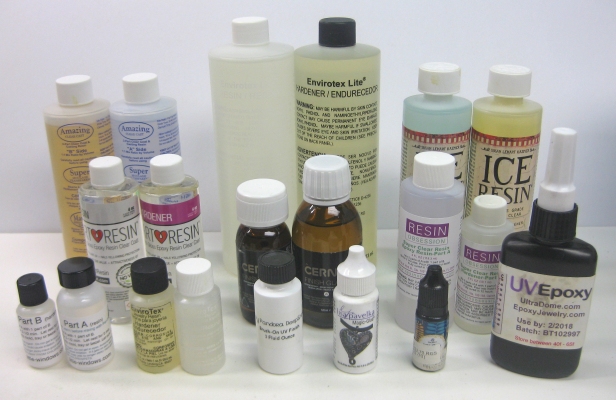
My experiences with resin started when I was trying to put an even coat of resin on a curved cabochon with EnviroTex Jewelry Resin. The resin looked perfect when wet, but as it dried, the top developed bare spots and the sides were thick with sagging resin. I tried another coat and it smoothed it out somewhat, but I thought there must be a better way.
To figure this out, I bought the following brands of epoxy resin and a UV lamp and commenced testing.
- Alumilite Amazing Clear Cast
- Cernit Kit Finish Glass
- EnviroTex Jewelry Resin
- EnviroTex Lite Pour-On High Gloss Finish
- Ice Resin Jeweler’s Grade
- Lisa Pavelka’s Magic Glos – UV
- UltraDome UV Epoxy – UV
- Art Resin
- Little Windows
- Resin Obsession
- Pandora Deep Shine – UV
- Chinese resin from Amazon (I don’t know if it has a brand name) – UV
Most in the list above are two-part resins. There are two bottles of liquid (resin and hardener) that you mix together and let cure for many hours. Once mixed, you either use it or throw it away because it will harden. Some are one part to one part (1:1) and some are two parts to one part (2:1).
Four in the list above are UV resins and I’ve marked them UV. There’s only one bottle, no mixing involved and the resin stays wet until you cure it with a UV lamp for up to 20 minutes. If you don’t want to buy a UV lamp, you could set your resin-covered pieces in the sun and protect them from bugs, dust and weather.
I thought about testing Pebeo Gedeo Crystal Resin, but I saw a cured sample in the local art supply store and it had pulled away from the edges a little.
I also tried Loon Outdoors UV Clear Finish and their UV flashlight because I’d read a review by someone who’d used it on polymer clay and said it worked wonderfully. It’s made for tying flies for fly fishing. For me, it remained sticky. I cured it for 20 minutes under the UV lamp and it turned yellow and was still sticky.
TESTING METHODS
I first made small, flat tiles from polymer clay. I used a Cabezel mold to make another set of tiles with bezels. After they were baked and cooled, I wiped them with rubbing alcohol to clean off any oils and labeled them with a Pilot pen.
Following the manufacturer’s instructions, I mixed and applied resin. I tried to put the same amount on each flat tile and covered them all to the very edges. I filled the bezels until they didn’t look like they could hold any more without running over.
After letting them sit for a few minutes, I removed the air bubbles by passing the flame of a BBQ lighter close to the surface.
Next, I cured the resin as directed by the manufacturers. I used either the UV lamp or set it aside to cure for 24 hours, covered with little plastic tubs to keep out the dust. Warmth helps resin to cure faster, but I just put the tiles on a shelf in the basement where it’s about 68-70˚F. Resin doesn’t like humidity when curing. That’s rarely a problem where I live.
Resin may need a few days to completely cure. I put some test pieces in a plastic baggie prematurely and a couple tried to stick together. The surface of the EnviroTex Lite was a tiny bit sticky, so maybe I didn’t get the parts exactly equal.
WHY RESIN?
Resin gives a hard, clear, glass-like finish. There’s almost nothing like it for bringing out the shine in mica powder. It can be wonderful, if you use the right brand for the right purpose.
It adheres like glue to surfaces and you can actually use it as a glue. I’ve only used it on Premo, Pardo and Cernit, so I can’t say how well it adheres to other brands of polymer clay. I’ve been able to pull it off of Pardo, but it wasn’t easy.
It can also be messy and frustrating. It can spill out of your bezel. It can sag and develop bare spots. It can get bubbles and dust in it. It can refuse to harden or it can harden in the bottle. It can turn yellow if not mixed in the proper proportions, or if exposed to more heat than it’s designed to tolerate, or if exposed to the sun too long. Some epoxy resins have UV stabilizers to prevent yellowing by the sun.
WHY EPOXY RESIN?
Epoxy resin is good for a beginner, which I am. It has very little odor, but you need to use it in a well-ventilated area and/or wear a respirator mask. It isn’t as toxic as polyester or polyurethane resins. It’s not rubbery like silicone resins.
ONE PART AND TWO-PART EPOXIES
There are one part and two part epoxies. One part epoxies cure with UV light. Two part epoxies cure from the heat caused by the chemical reaction caused from mixing the two parts together.
UV resins can also be called gel resins. I’ve read that gel resins tend to crack and aren’t as durable as two-part epoxy resins.
UV LAMP
I had a Loon UV flashlight, but it was small and didn’t seem practical for the 20 minute cure time that UltraDome needs, so I needed a 36 watt black light.

After shopping and comparing, I settled on the NailStar™ 36 Watt Professional UV Nail Dryer Nail Lamp. I chose it because it had a “constant” setting on the timer, instead of just 2-3 minutes. There are many other good lamps available. Just be sure to get the type of light your resin requires. For the brands I bought, I needed a black light rather than an LED light.
I really thought about buying a UV nail lamp that was large enough to put in two hands at once. If I ever do larger resin pieces, it’s good to know it’s available.
THE RIGHT TOOL FOR THE RIGHT JOB
My main goal was to find a resin that wouldn’t pull back from the edges of a flat piece or create bare spots in the top of a curved piece. I wasn’t really interested in doming or molding.
For jewelry, there are basically three types of resin:
- doming resin
- casting resin
- those that try to do both
Doming resin is designed to contract into a rounded dome when poured into a bezel. It has a high surface tension. It can also be called coating resin.
Casting resin is designed to be poured into a silicone mold. It has a low surface tension.
Those are simplified examples. In general, a doming resin contracts more than a casting resin. People use resin for many things besides bezels and molds.
For clear explanations of resins and fairly easy resin projects, including using resin with polymer clay, see The Art of Resin Jewelry by Sherri Haab. For more unusual projects, see Susan Lenart Kazmer’s book Resin Alchemy: Innovative Techniques for Mixed-Media and Jewelry Artists.
It’s not always clear from the manufacturer’s descriptions what type of resin it is and what purpose it’s meant to serve. I learned much from reading articles by Katherine Swift at ResinObsession.com. I’d suggest her Resin Choices Chart and What Are the Different Types of Resin? article. If you join her email list, she’ll send you her free ebook “50 Tips to Help You Be Better with Resin.”
DOMING
The best doming resins were:
- Magic Glos
- Little Windows
- Cernit Kit
- Ice Resin
- EnviroTex Lite
Magic Glos made the best dome.
In my observation, a doming resin will contract until it reaches whatever thickness its chemical makeup dictates. To cover a flat piece with a doming resin, you either need a very thick coat or multiple coats.
If you’re trying to cover a flat piece with a resin that really domes, it will pull away from the edges either immediately, or while it cures. To prevent this, I tried sanding the surface of the polymer clay to give it some tooth, thinking the resin might stick better. I tried varnishing the surface, thinking it was rejecting the polymer. Neither made any difference.
FLAT SURFACES
The resins that didn’t pull back from the edges of a flat surface at all were:
- UltraDome
- Deep Shine, though I got bubbles in mine
Resin Obsession, Art Resin, Amazing Clear and EnviroTex Lite only pulled back a little. The rest pulled away from the edges much more.


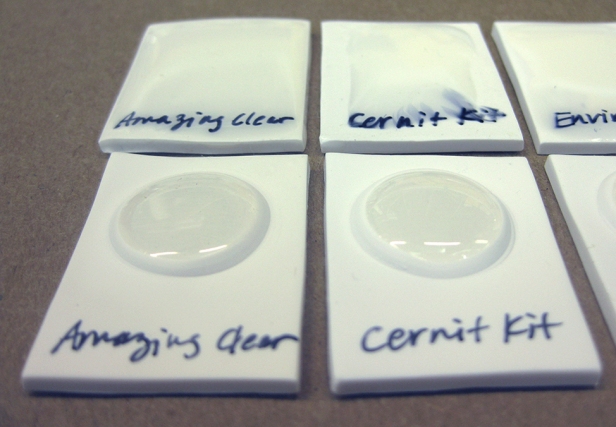


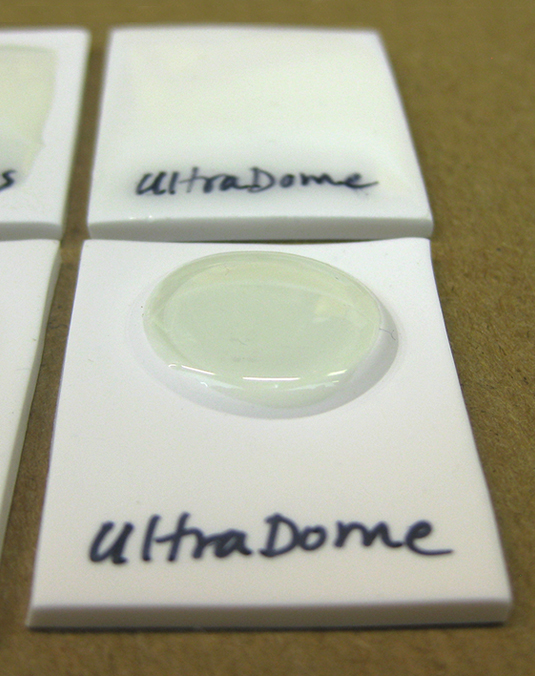

Resin Obsession domed somewhat and it didn’t pull back from the edges.
Little Windows domed well, but pulled back from the edges a lot.
Art Resin domed and didn’t pull back from the edges.
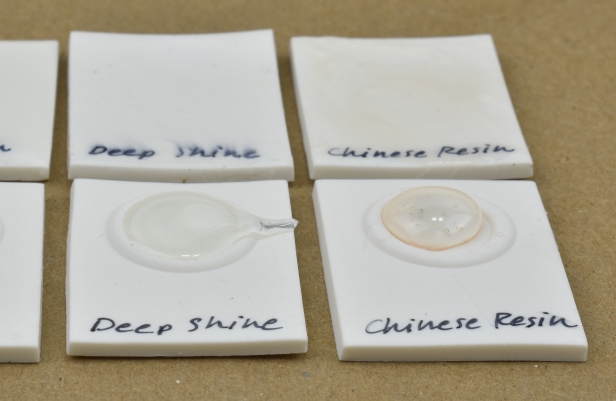
I followed the directions for Deep Shine and used the brush that came with it. I should have washed the brush first, because I got lots of lint in the resin. I wiped the resin off and reapplied it thinly with a gloved finger. The directions also say to not apply it thickly or it will get bubbles, so I guess I applied it too thickly because I got bubbles and the surface wasn’t smooth. It is not a doming resin. Strange thing is it made the clay curve up.
The bottle of Chinese resin I got was like thick glue and wouldn’t self-level, had lots of bubbles and remained sticky. I put it under the UV light for longer and it started to turn orange. I understand I got an old, bad bottle. Some people really like this when it’s fresh. It took three weeks to arrive from China, so I don’t really want to order another one.
MOLDS
I haven’t made any resin pieces from molds, but you’ll probably get a better result with a casting resin, such as Alumilite Amazing Clear Cast or EnviroTex Lite Pour-On.
You can make your own silicone molds from 2-part molding putty or you can buy silicone, polypropylene or polyethylene molds specifically made to use with resin. Using a spray-on mold release product or olive oil prevents sticking. Resin can stick to some plastic and rubber molds, so verify beforehand whether they’ll work with resin. Flexible molds make it easier to pop out the cured resin than rigid ones.
BUBBLES
Some of the resins tested had bubbles. The bubble-free resins were:
- UltraDome
- Ice Resin
- Amazing Clear Coat
- EnviroTex
- EnviroTex Lite
- Cernit Kit
- Magic Glos
- Resin Obsession
It’s a good practice to let resin rest for 10 to 20 minutes to allow bubbles to rise to the surface where you can pop them.
I’ve read that some brands are less prone to bubbles than others and the thicker the resin, the harder it is for it to release bubbles. If resin is too thick, you can put its container into hot water bath to thin it.
Using a flame works and it’s satisfying to watch bubbles pop that you didn’t even see. Don’t get too close with the flame because excessive heat can change the surface of the resin. I’ve read it’s the carbon dioxide from the flame that bursts the bubbles, not the heat. You can also wave a heat gun over it. With the heat gun, maybe the heat makes the resin thinner so it releases the bubbles.
If you have surface bubbles or sags in cured epoxy resin, you can sand them out and apply another coat to restore the shine. Another coat forgives a lot of mistakes. Buffing lightly can give a satin finish, but I haven’t found it to bring back the extreme shine. It can make whitish areas, if you overdo it.
I understand that polyester resin doesn’t get bubbles and you can buff it to a high shine, but there’s the smell and toxicity to deal with.
COLORLESS?
The most colorless resins were:
- Ice Resin
- Art Resin
- Resin Obsession
- Little Windows
- UltraDome
- Deep Shine
- Magic Glos
The rest had just a tiny bit of a greenish or amber cast. The thicker the resin, the more obvious these color casts become.
YELLOWING
This YouTube video shows several brands of resin and how they yellow over time when exposed to UV light.
SMELL, TOXICITY & CLEANUP
It’s very important to read all the instructions that come with resin. Some brands have more complete instructions and material safety data sheets (MSCS) than others.

After reading about the allergic reactions people have had to resin, I protect myself. None of the resins I used were polyester, polyurethane or silicone, so they didn’t have much of a smell. That doesn’t mean they’re not harmful. Some of the warnings say to not inhale the resin or recommend using it in a well-ventilated room. None of the brands I used recommend using a mask, but I wear one. Make sure your mask is made for vapors or fumes, not just for particles.
Wear nitrile gloves, not latex. Latex can have a reaction with resin or allow resin to penetrate to your skin. Some people are also allergic to latex. Don’t get resin on your skin or in your eyes. You can clean up your work surfaces with alcohol or baby wipes, but if you get it on your skin, use soap and water.
Once resin is cured, it’s hard to remove, so do a thorough job cleaning up. You can try an Xacto knife, razor scraper, sandpaper or acetone (fingernail polish remover) to remove dried resin.
CONCLUSION
UltraDome is the best UV resin for good, flat coverage to the edges without bubbles. It works well to cover curved surfaces and give a fairly thin coat to flat pieces. My second choices for this would be Alumilite Amazing Clear Cast, EnviroTex Lite or Resin Obsession.
Lisa Pavelka’s Magic Glos made the highest dome. Don’t expect a thin layer of it to cover a flat surface because it will pull back a lot. A really thick layer or multiple coats might remedy this. Ice Resin, Cernit Kit Finish Glass and EnviroTex Jewelry Resin also made nice domes.
Ice Resin, Art Resin, Resin Obsession, Little Windows, UltraDome, Deep Shine and Magic Glos were colorless. The other resins tested had a slight green or amber tint.
If I had to pick one UV resin, it would be Ultradome. If I had to pick one two-part resin it would be Amazing Clear or maybe Resin Obsession.
WHERE TO GET SUPPLIES
Most of the resins I tested are commonly available through art and craft stores or online. I believe online is the only way to buy UltraDome at UltraDome.com or EpoxyJewelry.com.
Cernit Kit Finish Glass is a new product and currently seems to be available only in Europe. I ordered mine from PerlesandCo.com and it arrived promptly.
I bought my UV nail lamp through Amazon.com

COVERING BEADS WITH RESIN
Curing an even coat of resin on round beads and cabochons is more involved than just using the right resin. If you’d like to learn how I do it, I have a Faux Moonstone tutorial that explains my methods in detail.
UPDATE 12-21-2018: I checked on the resin samples nineteen months after the original test. They’d been sitting in a closed box in my windowless basement with very little exposure to light. The EnviroTex and EnviroTex Lite have both yellowed . EnviroTex Lite more than EnviroTex. The rest of the brands look about the same.
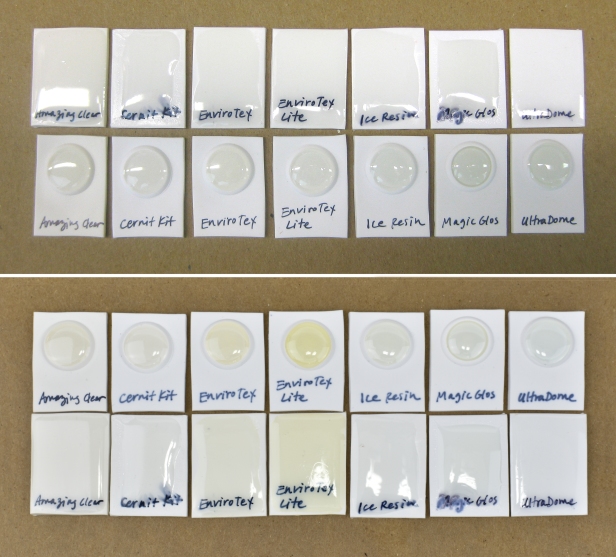

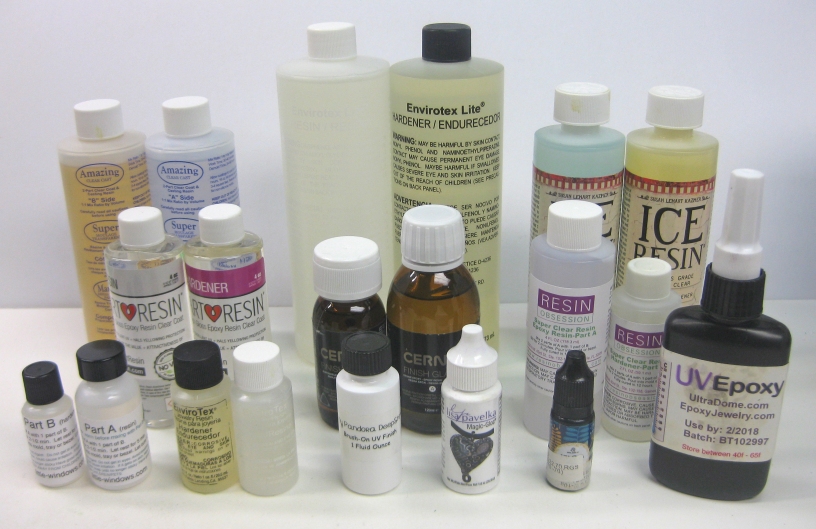
I have been using Ultradome on my Fimo Professional clay for 4 or 5 years now. The only time I had issues was when I used some that was old, it thickened up, the bubbles didn’t want to release, and some pieces stayed tacky. Other than that time, I love love love Ultradome!
LikeLike
Thank you for letting me know. I’m impressed with UltraDome.
LikeLike
You should add Little-Windows to your list to try. I have used it for years. Beautiful job, no smell, easy to use, doesn’t yellow over time., great customer service.
LikeLike
Thanks! I’d never heard of it.
LikeLike
Thanks, Katie!
LikeLike
Interesting results. I have tried some of these, and for sure my favorite for small batches is Ultra Dome. It’s so cost effective and the company has been very responsive in answering my questions. A quick spritz of rubbing alcohol helps with the bubbles (the alcohol needs a few minutes to evaporate fully though, the resin doesn’t cure otherwise). I have been wanting to try out Liquid Diamonds, but it’s more suited to casting than doming, so I’m not sure how much I will use it. Thank you for your experiments!
LikeLike
Thanks for the rubbing alcohol tip! I hadn’t heard of that.
LikeLike
I bought some Magic Glos today and it was hard in the bottle. Has anyone every bought that and had that trouble?
LikeLike
Resin has a shelf life, so that does happen. Hopefully you can return it.
LikeLike
When pouring or coating a dry surface, it often helps to put a little resin on the object with a popsicle stick and spread it gently to start it. You’ll find there are less surface bubbles when you pour the rest.
LikeLike
Thanks for the tip, Amy!
LikeLike
Thanks for getting right to the point seems I had already come to same conclusion as for the how of it I may have to learn in the doing as opossum to the tutorials this is to be determined as both options cost
LikeLike
Darn autocorrect not opossum
LikeLike
Thanks so much for your generosity in sharing your experiments! I’m new to pc and reading everything I can to avoid costly and sad mistakes. I saw a YouTube tutorial suggesting Famowood resin and that it’s much less expensive than craft store resin. It’s only less expensive if it actually works! Most of us don’t have money to buy and toss useless products in the trash. Ultra Dome it is! Thanks again!
LikeLike
Thanks, JoAnn! There’s a YouTube video showing Famowood really yellows in the sun.
LikeLike
Now that craftartedu is going away, is your moonstone tutorial available anywhere else?
LikeLike
Thanks for asking! It’s available in my Etsy shop. http://www.etsy.com/shop/busynuthatchdesign
LikeLike
Thank you for the valuable information. Have you ever tested/tried the one-part “UV Resin” being sold by Amazon?
LikeLike
Thanks for reading! The only one-part UV resins I’ve tried have been Lisa Pavelka’s Magic Glos and UltraDome. There are a lot of resins out there.
LikeLike
Thank you for your prompt reply. Happy New Year!
LikeLike
I am having issues with the resin contracting and pulling up either end (top and bottom) of very thin long narrow pieces of clay in earrings. Is there any fix for that? I tried resining the other side to hope it would balance tot out but still didn’t work and looks curved on a side profile which is not good for earrings! Any ideas please?
LikeLike
Yes, it does that and it’s annoying. What I can think of is to make your clay thicker or use a brand that is less flexible, like Kato.
LikeLike
Another thing you might try is a non-doming resin. The doming resins tend to contract as they cure.
LikeLike
I teach a polymer clay class for middle and high school children. We made a wading pool, fully baked, from polymer clay. Then filled the pool with two part resin purchased at Joann’s. Once hardened, a cute turtle on a blow up raft (also made from clay, then baked) was placed on hardened resin, filled pool. The resin was covered in another thin layer of resin to make it appear like the turtle was floating once placed on the liquid layer. Everything looked adorable. However, within a month or so, the resin started to yellow and it also cracked severely.
I was hoping you could help me figure out what we did wrong and what resin I could use that would better suit this project? There pools were about 2.5″ W X 1″ H The students worked so hard to then have their adorable creations ruined.
Thank you.
Jessica
LikeLike
I’m sorry to hear that! I wish I could help you, but I’m really not a resin expert and don’t know why it cracked. My tests were for yellowing and you can see the results from that. Maybe there’s a resin FaceBook group that would know more.
LikeLike